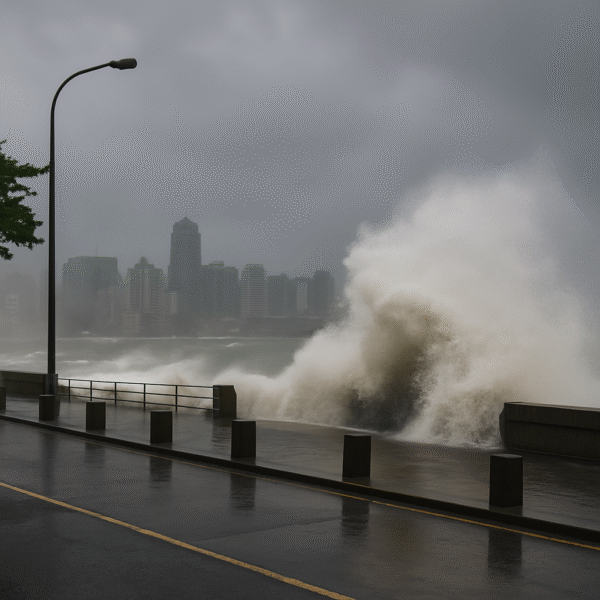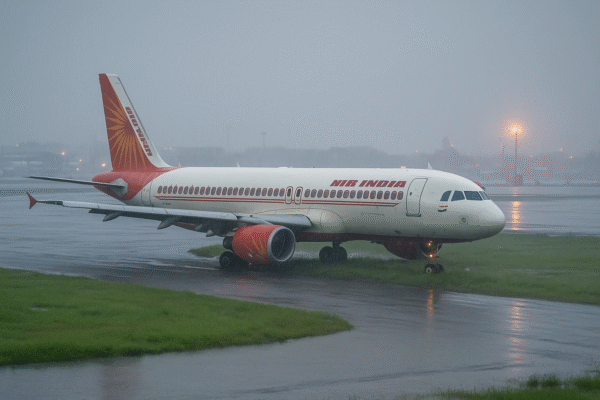A potentially catastrophic aviation scare unfolded at Chhatrapati Shivaji Maharaj International Airport (CSMIA) on Monday when Air India flight AI2744 skidded off the main runway while landing during intense monsoon rains. The flight, arriving from Kochi, encountered treacherous weather and poor visibility during touchdown, triggering renewed concerns about India’s aviation safety standards during seasonal downpours.
The aircraft, which reportedly veered slightly off-course due to the slippery conditions, was able to regain control quickly thanks to the crew’s swift action. No injuries were reported among passengers or crew, and the aircraft safely taxied to the terminal after the incident.
Tense Moments During Touchdown
According to multiple eyewitness accounts and initial airline reports, passengers onboard AI2744 felt a “strong jolt” followed by a noticeable swerve as the aircraft landed on Runway 09/27, the airport’s primary landing strip. The aircraft temporarily slipped left of the centerline but avoided a full excursion thanks to the pilots’ rapid response and effective coordination with ground control.
Footage circulating on social media showed soaked tarmac conditions and reduced visibility at the time of landing. Aviation analysts have since applauded the cockpit crew for their “exemplary airmanship” under extremely challenging weather.
Safety Measures Ensured; Quick Evacuation Not Required
Despite the alarming maneuver, all 182 passengers and crew members aboard were confirmed safe, according to a statement from Air India. Since there was no fire, smoke, or structural breach, there was no need for emergency evacuation, and passengers disembarked as usual once the aircraft reached the gate.
Air India’s spokesperson added that the airline was working closely with the Directorate General of Civil Aviation (DGCA) to assess the cause and circumstances of the incident. Flight AI2744’s aircraft, an Airbus A320neo, was grounded temporarily for inspection, although no major damage has been reported so far.
Minor Runway Damage, Temporary Diversions
Airport operator Mumbai International Airport Limited (MIAL) confirmed that Runway 09/27 suffered minor surface damage from the incident. As a precaution, all flight operations were temporarily shifted to the secondary Runway 14/32, which remains operational during peak monsoon periods.
MIAL activated its monsoon contingency plan, deploying technical teams for immediate inspection and restoration. Runway 09/27 resumed partial operations later the same evening after repair protocols and safety validations were completed.
Aviation Safety Under Scrutiny Amid Monsoon Turbulence
This incident is the latest in a string of monsoon-related disruptions at Indian airports and has sparked renewed debate among aviation safety experts. Mumbai’s airport, which handles over 950 daily movements and more than 45 million passengers annually, is particularly vulnerable during the June–September monsoon season.
Experts are calling for an urgent review of runway surface treatments, drainage systems, and pilot approach protocols during adverse weather conditions. “We cannot afford to gamble with safety during the monsoon. Airports like Mumbai need to be equipped with enhanced friction testing, better rain dispersion systems, and more frequent runway inspections,” said aviation analyst Captain S.P. Mehra.
The Ministry of Civil Aviation (MoCA) has already mandated increased safety audits for monsoon season since 2023, but incidents like Monday’s suggest enforcement gaps still exist.
Traveler Confidence and Economic Ripple Effects
Although no lives were lost and no visible damage occurred to the aircraft, the scare has led to concern among travelers already wary of weather-related flight disruptions. Social media was awash with passenger testimonials praising the calm handling by crew, but also calling for more transparency from airlines regarding weather protocols.
Travel advisors suggest that incidents like this could impact Air India’s brand trust and travel insurance premiums during the monsoon season. Mumbai is a vital hub for both domestic and international tourism, and any blow to passenger confidence risks wider economic impacts.
According to India Brand Equity Foundation (IBEF), aviation is a cornerstone of India’s $250 billion tourism economy. Ensuring consistent safety, particularly during seasonal risks, is crucial for maintaining momentum in both leisure and business travel.
Lessons Learned and the Way Forward
The Air India incident serves as a timely reminder of the unpredictability of extreme weather and the importance of robust emergency preparedness. Aviation authorities and airport operators must collaborate on data-driven risk modeling, frequent crew training, and up-to-date weather-monitoring technologies.
Mumbai, along with other high-traffic Indian airports like Delhi IGI, Bengaluru Kempegowda, and Kolkata NSCBI, are now being urged to prioritize investments in Weather Resilient Infrastructure (WRI) and Advanced Runway Surface Condition Monitoring Systems (ARSCMS).
While this incident ended without injuries, its implications for India’s aviation future are significant. As climate change increases the frequency and intensity of weather anomalies, India’s airports must evolve from being reactive to proactively weather-ready.
For more travel news like this, keep reading Global Travel Wire






















